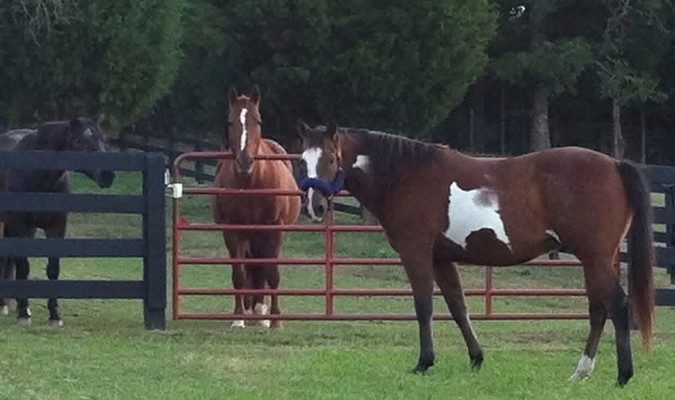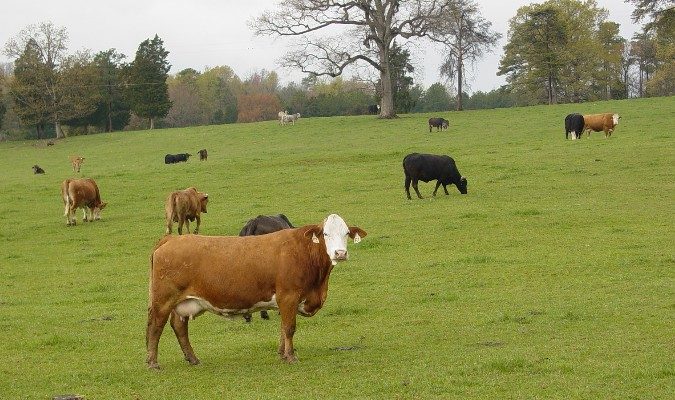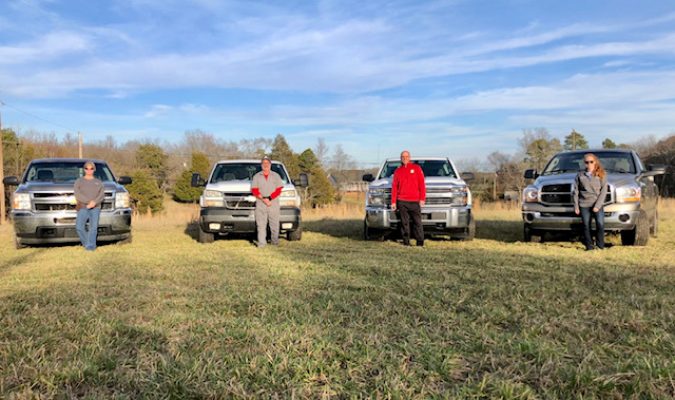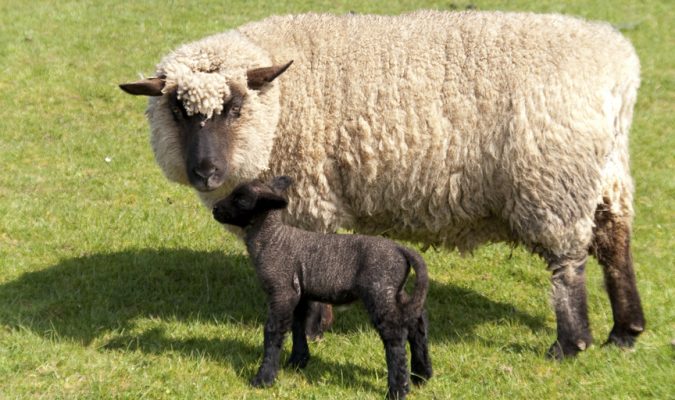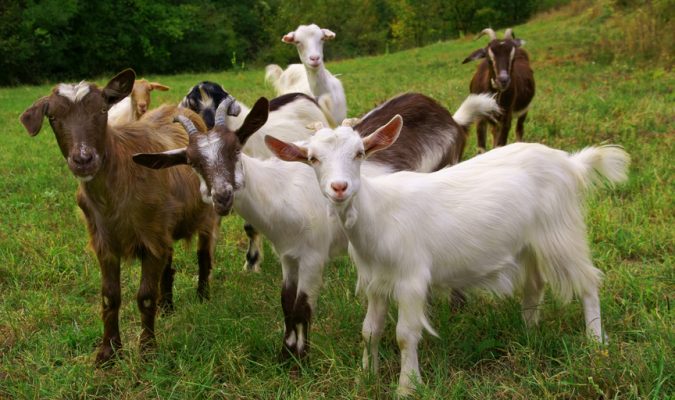The Start of Monthly Newsletters
Rocky River Large Animal Veterinary Clinic will now be providing monthly newsletters that will be posted on our website and Facebook page. Our hope is to provide a trusted resource for the people that trust us. Each month, the newsletter will cover timely topics and reminders to give you, our clients, opportunities to stay informed and up-to-date on the latest in veterinary care. We won’t be able to discuss everything regarding each topic, but we will definitely get the conversation started. This newsletter will promote the services we are currently offering and will enable us to gauge the need for future services based on your feedback.
If there’s a topic you’d like us to discuss let us know!
Conquering The Flies

Figure 1: Common Livestock Fly Identification.
A comment we’ve been hearing repeatedly this summer, and experiencing ourselves, is the prevalence of flies. Just imagine having to live outside with those relentless bugs 24 hours a day like your animals. The types of flies on your farm can vary based on a number of factors like the species of animals present and environmental conditions. Here are some general management strategies to provide your animals some relief- regardless of the type of fly.
Cleanliness and sanitation is the most important (and also the most time consuming) management strategy for both horses and cattle. Through removing decaying organic debris (feces/bedding/feed) you’re lessening the breeding ground for fly populations. It’s also important to manage moisture and ensure adequate drainage for your horse barn. For your horses, we would recommend having a designated manure pile away from your barn and in the sun if possible. Cover the designated manure pile with a dark tarp. This will create a physical barrier to prevent the flies from laying eggs and heat the manure up and help to kill the fly larvae. For your cattle, we would recommend breaking up manure piles out on pasture to allow the piles to dry out along with removing any wasted feed/hay.
Notably, Insect Growth Regulators (IGR) for either horses or cattle are designed to be fed on a consistent basis by all animals on the premise. Otherwise, the product is ineffective. The product’s effectiveness is further limited if your neighbor is not properly utilizing it. Also, IGR’s only work to limit fly larvae development in manure and do nothing for other organic debris such as feed or bedding.
Regardless of the products listed below, always follow the label directions for horses and cattle. For cattle, take note of the meat withdrawal for that specific product. Lastly, it should be stated that fly control should be a multimodal approach in order to achieve success. You will likely not achieve success using only one strategy.
Species Specific Tips:
Cattle: The main flies of concern for cattle are the pasture flies (horn fly and face fly). This is because face flies can spread pinkeye throughout the herd, and horn flies can cause significant weight loss due to stress and disrupted feeding patterns.
- Topical Sprays and Pour Ons: These can be effective in managing pasture flies (face fly and horn fly). These products have a shorter lifetime of only a couple weeks, meaning they will require repeated applications throughout the season to be effective.
- Dust Bags and Back Rubbers: These can be effective in managing pasture flies (face fly and horn fly). Back rubbers and dust bags are useful when placed correctly so that the cattle are forced to use them routinely. Ensure that dust bags are placed in a location out of the rain.
- Insecticide Ear Tags: These can be effective at managing horn flies, but not face flies due to their short contact time on the cow. It’s recommended to rotate the active ingredient yearly to minimize resistance. For best horn fly control, it is generally recommended to apply them to both ears, but always read the product label before use. This product only lasts roughly 120 days, so it is recommended to wait until horn fly populations are roughly 100 per side per animal.
Horses:
- Topical Sprays: There are countless fly spray brands out there. So, find the product that works best for you. If you’re using a concentrate be sure to follow the appropriate dilution instructions on the label. These sprays only seem to provide temporary relief, so reapplication is typically needed daily to be effective.
- Physical Barriers: Face mask, fly sheets, leggings, and screens on windows/entrances can provide a barrier to hinder flies accessing your horses.
- Mechanical Ventilation: Using fans (preferably designed for barns) directed on your horses or out of your barn can help to keep the flies from being able to land effectively and stay on your horses.
- Fly Traps: These are great products to use with little work required from you. However, if organic debris isn’t managed, then their effectiveness can be diminished.
- Fly Predators: This is a more inconsistent product with a short diameter of coverage. Most companies will provide a formula to use to calculate the amount to purchase. These likely work best when using them around a designated manure pile.
Further Resources:
- Article on ear tags in cattle: https://entomology.ca.uky.edu/ef505
- Article on cattle fly control: https://entomology.ca.uky.edu/ent11
- Article on general cattle fly control: https://beef.unl.edu/cattleproduction/controllingflies
- Article on horse fly control: Insect Control for Horses, Horse Barns, and Stables | Entomology (uky.edu)
- Article on fly control around the barn: https://entomology.ca.uky.edu/ef514
Beating The Heat

Figure 2: Temperature Humidity Index Guide developed by University of Wisconsin
Water & Minerals: No matter the type of livestock you own, they (along with you) are struggling to stay cool with this recent heat wave. It’s important to provide your livestock with sufficient amounts of fresh water. It’s estimated that an adult horse or cow will consume 1 gallon of water per 100 pounds per
day under normal conditions (60-70 degrees Fahrenheit). With higher temperatures that estimation can double.
There are several conditions that can lead to increased water needs for your livestock. For example, a lactating female (horse or cow) can have close to double the water needs compared to that animal at maintenance. It is also estimated that horses under hard work in high temperatures can produce 2-4 gallons of sweat per hour. Horses under work could benefit from having an electrolyte supplement along with their regular water to help replace what was lost in sweat. There are countless brands of horse electrolytes that can be used to supplement your horse’s water intake.
Notably, grain feed for horses does not contain the minimum amount of salt, because if it did the feed would be unpalatable for the horse. Therefore, it’s recommended to provide free choice loose salt to your horse all year round to promote drinking. If you choose to top dress your horse’s feed with table salt then it’s recommended to use 1 tablespoon of loose table salt per 500 pounds per day. Adding salt or an electrolyte supplement to your horse’s diet can help them replace what they’re losing in sweat and encourage water
consumption.
To ensure your water is adequate for the species of animal you run on your operation. Getting your water tested through your county extension office can ensure levels of things like nitrate, lead, sulfate, total dissolved solids, and pH are at acceptable for your animals. Also if there is a lack of rainfall, these potentially toxic ions can concentrate, making the likelihood of toxicity greater. Below you’ll find a link to a useful article regarding pasture grazing and water quality as well as an article by the University of Missouri that discusses the importance of water quality. Also listed below is a link to the North Carolina Department of Agriculture for more information on cost and sample submission. Basic water sample submissions
are $5.00 for NC residents.
https://efotg.sc.egov.usda.gov/references/public/NC/farmassistgrazing.pdf
https://extension.missouri.edu/publications/eq381
https://www.ncagr.gov/divisions/agronomic-services/solution-analysis/growers
Shade & Ventilation: Along with a quality water source, providing ample shading and ventilation for your livestock can make them more comfortable. If your pastures don’t offer much in the form of shade, it can be constructed as either permanent or portable structures to help give your animals some relief.
- Horses: Limit turnout to the cooler parts of the day along with using fans to keep your horses cool. Also, don’t forget about your Cushing’s horses and ensuring they are clipped appropriately, because one side effect of Cushing’s is the inability to sweat. So, these horses need all the help they can
get! - Cattle: It’s been shown that providing shade for your cattle has multiple benefits from weight gain, improved fertility, greater pasture usage, and improved water quality. Check out this great article on shade options and the benefits for cattle through the Kentucky Extension Service for more information.
https://www2.ca.uky.edu/agcomm/pubs/aen/aen99/aen99.pdf
Work & Transportation: If you’re working livestock this time of year, it’s advised to do these activities early and avoid the heat as much as possible for everyone involved. Using figure 2 shown above, it’s recommended to only work cattle when the temperature humidity index is 72 or less. When it comes to
riding horses it’s recommended that the combination of temperature and humidity added together is less than 130. If transporting cattle or horses, it’s recommended to trailer them early in the morning, ensure adequate ventilation, limit stops, and only travel short distances. Otherwise it’s recommended to
postpone transport until cooler temperatures.
- Horses: When working horses in the heat it’s recommended to not exert them past their current level of training. Be sure to provide them plenty of breaks along with water. During the breaks you can also sponge or hose their neck, back, rump, and legs with cold water to help keep them cool.
- Cattle: For cattle their body temperature peaks 2 hours after environmental temperatures peak and then it takes an additional 4-6 hours to get their body temperature back to normal. So, it is recommended to leave the evening hours to allow cattle to recover from the heat. Additionally, when evening and night temperatures fail to fall below 70 degrees Fahrenheit, the cattle have little to no chance to recover before another day of heat humidity.
If you have any questions regarding the topics discussed in this article, please don’t hesitate to contact us. If you’d like to do a farm consultation to discuss management strategies for heat mitigation, water, and flies we’d be more than happy to assist. We may not have all the answers to address all your concerns, but by working with forage specialists, water quality specialists, and veterinary entomologists, we can get you there.
Written By: Dr. Gunner Edgell
Rocky River Large Animal Veterinary Clinic is here to serve you and your animals.

